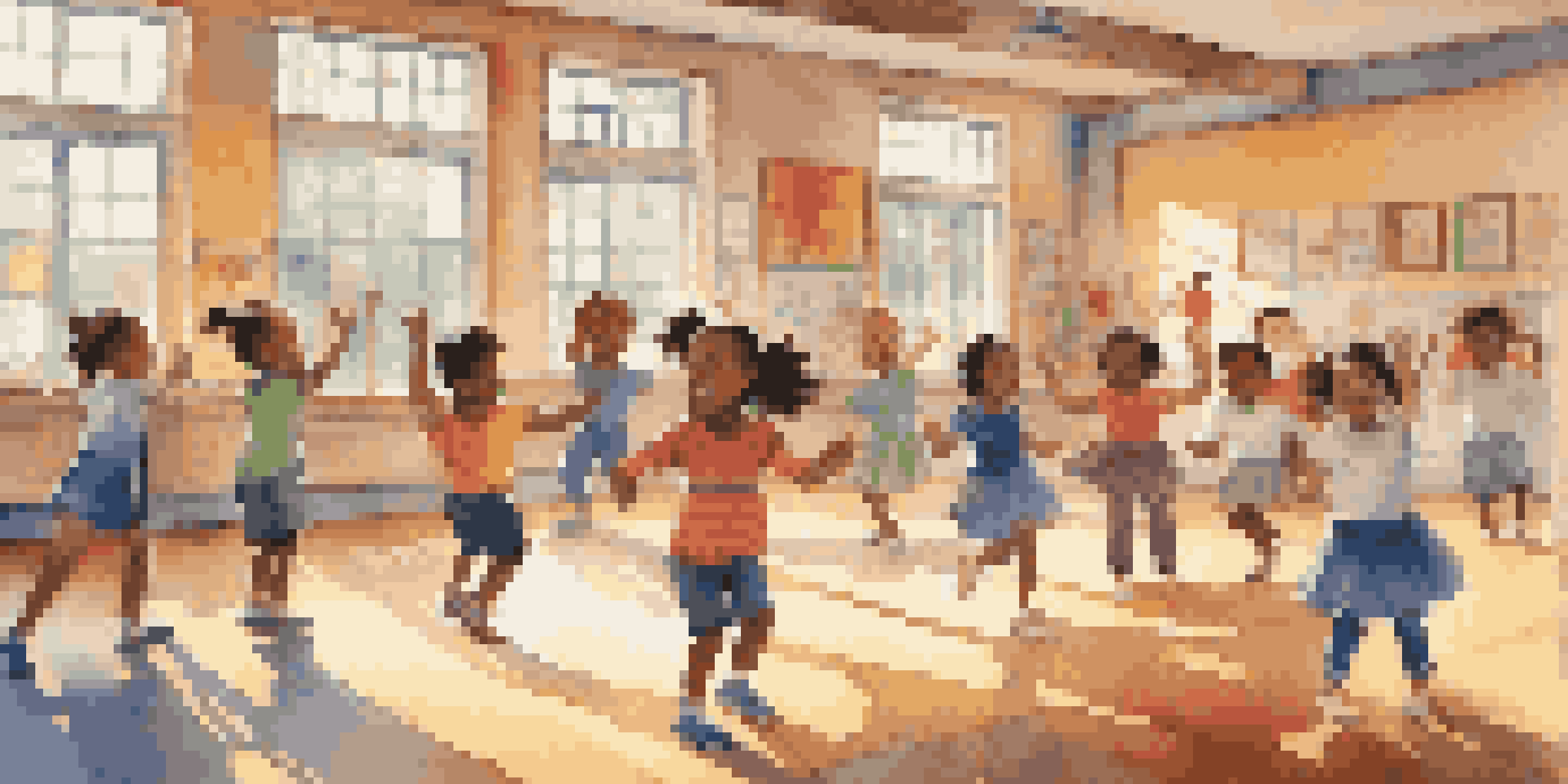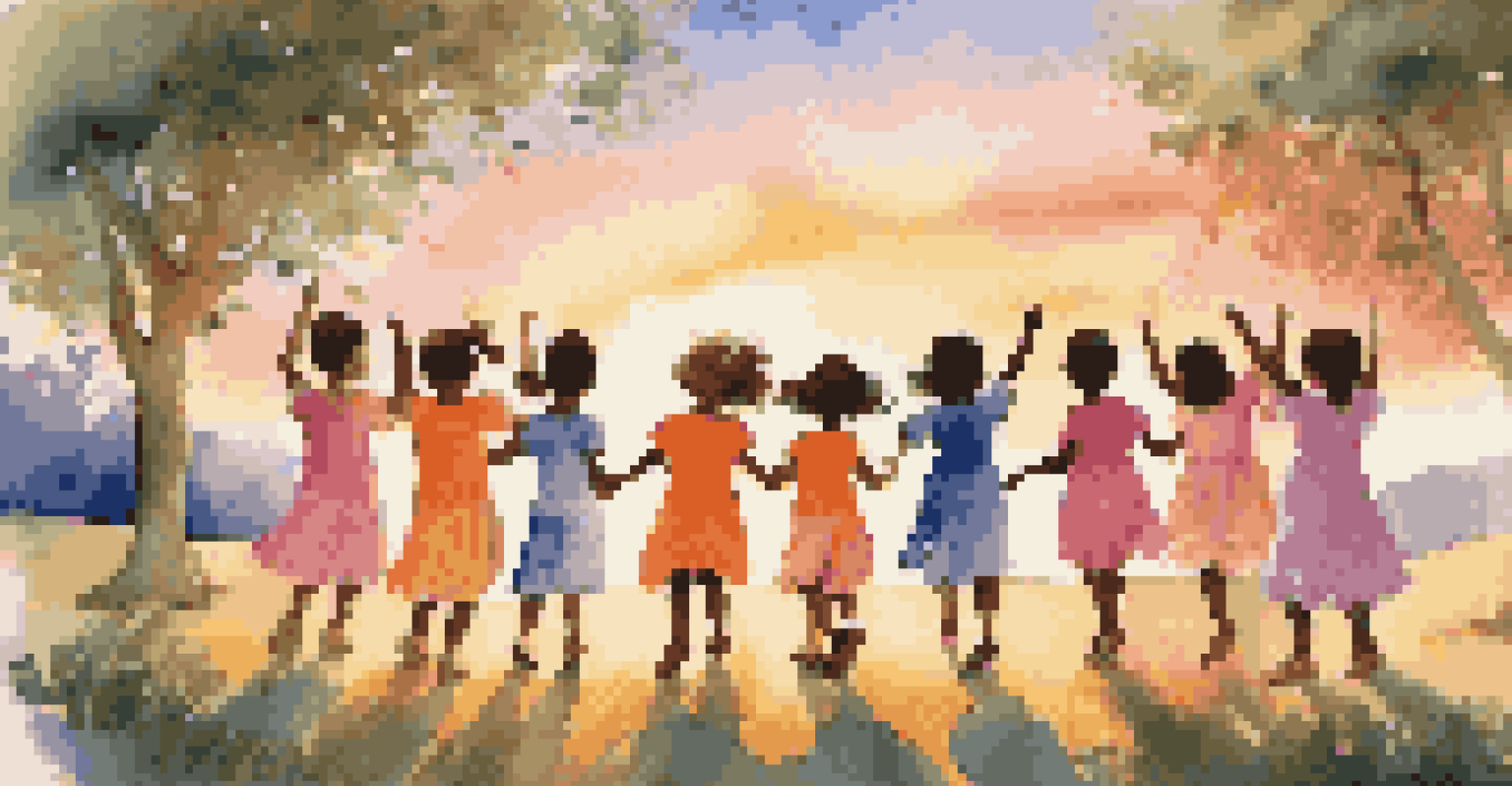Dance Games: Merging Fun with Developmental Learning

The Joy of Dance Games in Learning
Dance games blend movement and music, creating an engaging environment for learners. When children dance, they naturally express themselves, making learning feel like play. This joyful atmosphere fosters creativity and encourages participation, which is crucial for developmental growth.
Dance is the hidden language of the soul.
Moreover, these games often incorporate rhythm and repetition, helping reinforce memory and cognitive skills. As kids learn new dance moves, they also practice coordination and balance, key components in physical development. The joyful nature of dance games means kids are more likely to engage and retain what they learn.
In essence, dance games transform traditional learning into a vibrant experience. They demonstrate that education doesn't have to be dull; instead, it can be a lively adventure that captivates young minds. This playful approach can lead to a more profound understanding of various concepts.
Cognitive Benefits of Dance Games
Engaging in dance games promotes critical thinking and problem-solving skills. As children learn to follow dance routines or create their own, they must think ahead and strategize their movements. This cognitive engagement is essential for developing essential skills like planning and organization.

Additionally, dance games often require memorization of steps or sequences, which enhances memory retention. This process stimulates the brain, encouraging neural connections that are vital for learning. In this way, dance becomes more than just physical activity; it serves as a powerful tool for cognitive enrichment.
Dance Games Boost Learning Engagement
Dance games create a joyful atmosphere that enhances creativity and encourages active participation in learning.
Furthermore, the collaborative aspect of dance games fosters social skills, as kids often play together. They learn to communicate, share ideas, and work as a team, all while having fun. These interactions build confidence and emotional intelligence, laying the groundwork for future social relationships.
Physical Development Through Dance
Physical activity is crucial for children's development, and dance games provide an excellent outlet. They encourage movement, which helps improve motor skills, flexibility, and overall fitness. By jumping, spinning, and moving with music, kids develop their bodies in ways that are both fun and beneficial.
Movement is a medicine for creating change in a person's physical, emotional, and mental states.
Moreover, dance games promote cardiovascular health, making them a great alternative to sedentary activities like video games. As children stay active, they build strength and endurance, which are essential for their physical growth. This focus on fitness helps instill lifelong healthy habits.
In addition to strength and fitness, dance games also enhance spatial awareness. Understanding personal space and how to navigate it while dancing is a valuable skill. This physical awareness translates into greater confidence in various environments, from playgrounds to sports fields.
Emotional Development Through Dance Games
Dance games can be a powerful avenue for emotional expression. They allow children to convey their feelings through movement, which can be especially beneficial for those who may struggle with verbal communication. This form of expression can lead to increased self-esteem and a better understanding of their emotions.
Participating in dance games also teaches resilience. When kids learn a new dance move that doesn’t come easily, they develop perseverance and a growth mindset. This experience of trying, failing, and succeeding helps them understand that challenges are a part of learning.
Cognitive Skills Through Movement
Engaging in dance games promotes critical thinking, memory retention, and social skills, enriching children's cognitive development.
Furthermore, dance games often create a sense of belonging and community. As children dance together, they forge friendships and support one another, enhancing their emotional well-being. This social connection is vital for developing empathy and compassion.
Incorporating Dance Games in Education
Teachers and parents can easily integrate dance games into educational settings. Simple activities like 'freeze dance' or 'follow the leader' can reinforce lessons in a fun way. By incorporating these games, educators can help break down the barriers of traditional learning environments.
Moreover, using dance as a teaching tool can cater to different learning styles. Kinesthetic learners, who thrive on movement, will particularly benefit from this approach. The inclusion of dance can make lessons more inclusive and engaging for all students.
Additionally, dance games can be adapted to teach various subjects, from math to language arts. For instance, rhythm can be used to teach counting, while storytelling through dance can enhance literacy skills. This versatility makes dance an invaluable resource for educators.
The Role of Technology in Dance Games
With the rise of technology, dance games have evolved to incorporate digital elements. Video games and apps that focus on dance offer interactive experiences that engage children in new ways. These technological advancements can enhance the fun while providing opportunities for learning.
For instance, programs that use motion sensors allow kids to see their movements mirrored on screen. This instant feedback can help them improve their skills while making the experience even more exciting. Technology can bridge the gap between traditional dance and modern learning.
Dance for Holistic Development
Dance games support physical fitness, emotional expression, and teamwork, contributing to children's overall growth and well-being.
Moreover, online platforms enable social interaction, allowing kids to dance with friends or family, even from a distance. This connectivity fosters a sense of community and teamwork, essential components of social development. As technology continues to advance, it will undoubtedly shape the future of dance games.
Conclusion: The Future of Dance Games in Learning
As we look to the future, the role of dance games in developmental learning will only grow. Their unique blend of fun and educational value makes them an ideal tool for parents and educators alike. By embracing dance games, we can cultivate a love for learning in children while promoting their holistic development.
With continued research into the benefits of physical activity, dance will remain a key player in educational strategies. The potential for creativity, social interaction, and emotional growth through dance games is immense. As such, they offer an exciting avenue for nurturing well-rounded individuals.

Ultimately, dance games remind us that learning can be enjoyable and enriching. By merging fun with education, we can empower the next generation to thrive both academically and personally. Let’s keep dancing towards a brighter future!